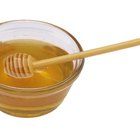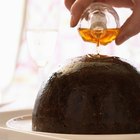
Derived from sugar cane and cooked down into a syrup, molasses adds moisture and sweetness to breads, cookies and other baked goods. Molasses can also be drizzled on hot cereals or stirred into coffee in place of sugar. Although molasses is a common and versatile kitchen staple, unless you frequently use it in large quantities you will need to store it between uses. Cold temperatures can extend the shelf life of molasses, but freezing may not be the way to go.
Frozen Molasses
Although it can be stored in the freezer, molasses does not freeze solid in most home freezers. The sugars in molasses act as an antifreeze and lower the freezing point of this sticky staple. Instead of the entire molasses mass freezing, the moisture within the molasses never comes close to freezing. As the water portion of molasses gets colder, the sugar crystals precipitate out. Later, when you thaw out the molasses, the once velvety liquid will be grainy with sugar crystals. This crystallization is much like what happens when honey crystallizes.
Fixing the Problem
Because repeated thawing and freezing only encourage the precipitation of more sugar crystals, if you do choose to store molasses in the freezer, portion it out first. Freezing the molasses in one-half cup portions or smaller will allow you to take out what you need as you need it and help you avoid the problem of repeated freezing and thawing cycles. To return your molasses to a smooth liquid, heat it gently in a warm-water bath. Heat the molasses only until the crystals have mixed back into the liquid. Another solution to the crystallization problem is to keep molasses out of the freezer.
Storing Molasses
The optimal place to store a jar of molasses is on your pantry shelf. This is true whether the jar has been opened or is still unopened. If the jar has been opened, make certain the lid is tightly closed before putting the jar away. Your pantry should be kept dark and within a temperature range of 50 to 70 degrees Fahrenheit. Opened jars of molasses may also be stored in the refrigerator but this storage method also puts your molasses at risk of crystallization. To reduce the chance of your molasses turning grainy, store it in the warmer portion of your fridge such the door shelves, rather than in the rear of the fridge.
Molasses Shelf Life
The shelf life of molasses is debatable. It can be used from six months to two years, depending on if it is open or unopened -- and depending on who you ask. A safe estimate is to use open or unopened molasses that is stored in the pantry within one year. Refrigerated molasses is good for up to another six months.
Related Articles
How to Soften Crystalized Molasses
How Long Can Honey Last Without Going ...

How to Store Discontinued Lipstick for ...

How Long Can You Keep Beer Refrigerated?

How to Fix Orange Marmalade That Turned ...

Can You Defrost Hamburger in Hot Water?

What Causes Honey to Crystalize

Does Corn Syrup go Bad?
Can You Freeze Capers?

How to Liquify Honey

How to Color Hair With Molasses
How Long Can You Keep Frozen Canadian ...

How Long & What Temperature Do You Bake ...

Do You Have to Refrigerate Glazed ...

Will Beer Freeze in the Freezer?

Does a Chilled Champagne Bottle Need to ...
How Long Can Food Stored in Canning ...

Red Currant Jam Recipe

How Long Can Meat Stay out of the ...

How to Make Blueberry Jam
References
Writer Bio
Based in Portland, Ore., Tammie Painter has been writing garden, fitness, science and travel articles since 2008. Her articles have appeared in magazines such as "Herb Companion" and "Northwest Travel" and she is the author of six books. Painter earned her Bachelor of Science in biology from Portland State University.
Photo Credits
Jupiterimages/Polka Dot/Getty Images